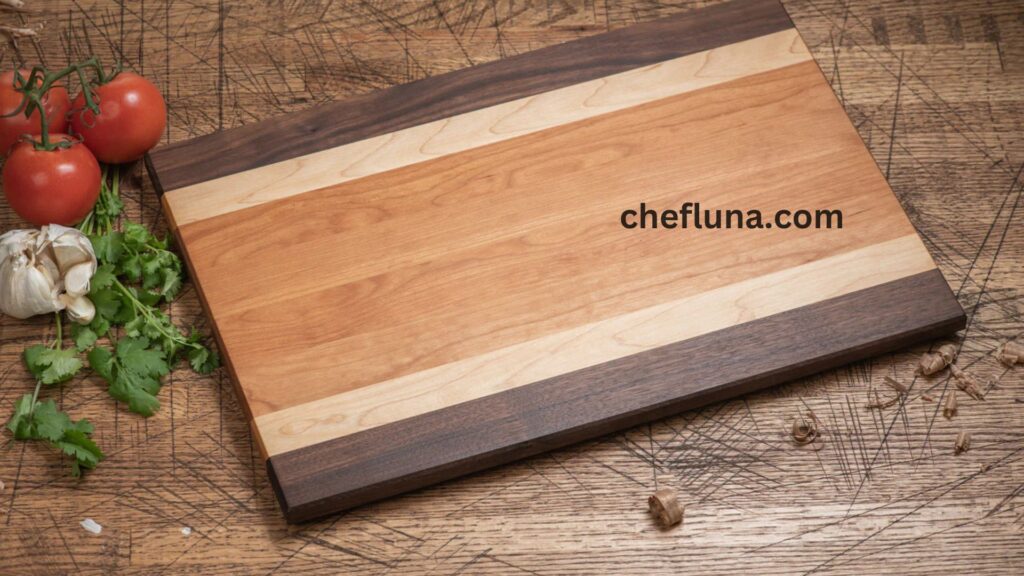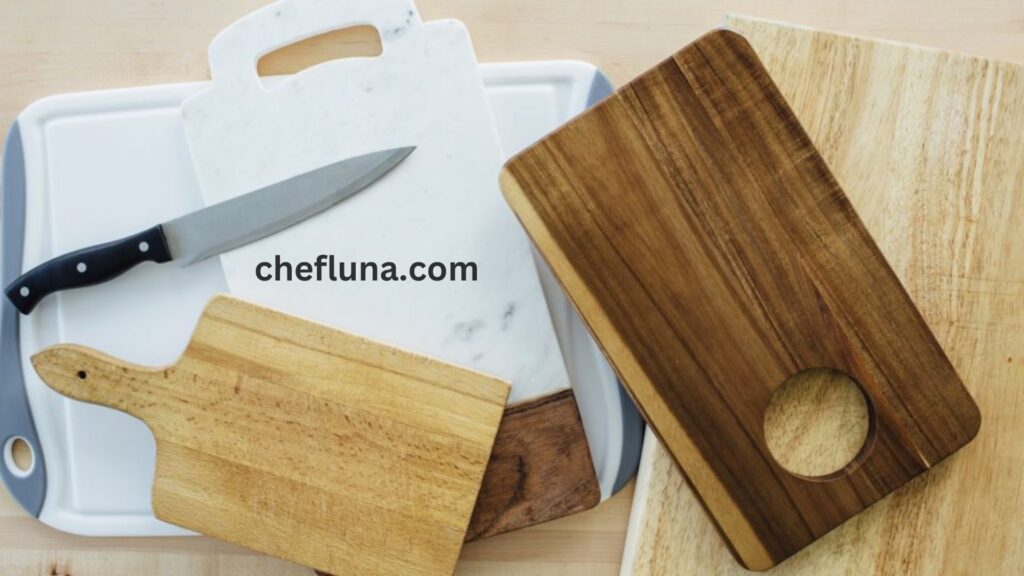How do I Select the Right Cutting Board?
How much time do you spend chopping and prepping food every day? Even if it’s just 15 minutes, that time adds up over the weeks. You deserve a cutting board that works as hard as you do—something that looks great, feels good to use, and fits the job you’re doing.
Choosing a cutting board might seem simple, but there’s more to it than you might think. It’s not just about looks—using the wrong board or not caring for it properly can turn it into one of the germiest items in your kitchen.
Here’s a quick guide to picking a cutting board that suits your budget and lifestyle, plus tips to keep it clean and safe!
Things to Consider When Choosing a Cutting Board
First off, take a deep breath. There’s no need to stress about cutting boards! You might’ve heard that certain materials aren’t safe, but the truth is, any cutting board can be safe if you follow proper food handling and cleaning practices (don’t worry, we’ll cover that).

When choosing a cutting board, here are some things to think about:
- Is it knife-friendly? A harder surface can wear down your knife faster.
- Is it easy to clean? If tossing it in the dishwasher matters to you, check if that’s an option.
- Is it low-maintenance? Some boards need regular conditioning with oil—are you up for that?
- What’s the cost? Does it fit your budget?
- How durable is it? Will it last, or will you need a new one soon?
- What size is it? Do you have enough space for it in your kitchen?
Keep these questions in mind, and you’ll find the perfect board for your needs!
Edge Grain vs. End Grain Wood Cutting Boards
Wooden cutting boards come in two types: edge grain and end grain, and each has its own pros and cons.
Edge Grain
Edge grain cutting boards are made from wood that’s cut with the grain, meaning the top of the board shows long wood fibers. These are the most common type of wooden cutting board and are usually the most affordable.
However, edge grain boards are more likely to show knife marks because the wood fibers don’t give much under the knife’s blade. (Think of chopping against the tree fibers.) This makes edge grain boards a bit tougher on your knives compared to end grain boards.
End Grain
End grain cutting boards are made by fusing cross-section pieces of wood together, so the top of the board shows the rings of the wood. These boards are often thicker, and since they’re harder to make, they tend to cost more than edge grain boards.
The nice thing about end grain boards is that the wood fibers bounce back from cuts better than edge grain boards, so they show fewer grooves over time. They’re also gentler on knives because the fibers have more give.

John Boos Block RA-Board Large Reversible Wood Cutting Board
The John Boos Block RA-Board is a large, reversible wood cutting board, ideal for chopping and food prep, with durable and stylish craftsmanship.
However, since end grain boards are made of several pieces of wood glued together, they can absorb more moisture if not properly cared for. If the board gets wet a lot, the seams might come apart over time, which could trap bacteria. To prevent this, it’s important to regularly condition the board with mineral oil or board cream, which helps keep it dry and prevents cracking. This is especially important for end grain boards.
Now, about edge grain boards being “tougher” on knives—this could matter if you chop a lot, but if you don’t, it’s not something to worry about. Any wooden cutting board will be gentler on your knife than materials like glass, Corian, or metal.
Maple, Oak, and Cherry Cutting Boards
With proper care, wooden cutting boards are safe, gentle on your knives, and can last a long time. They also come in a wide range of prices, from basic ones that cost around $20 to fancy handmade boards that can go for over $200.

Hardwoods like maple, walnut, cherry, beech, and teak are the most durable for cutting boards. These woods have smaller pores that help prevent bacteria from getting into the surface, and they’re less likely to develop grooves where bacteria can hide. Plus, wood naturally has antimicrobial properties, like tannins, which help keep things clean.
Caring for Wooden Cutting Boards: Never put a wood cutting board in the dishwasher. The high heat and harsh detergents can cause it to warp and crack.
Bamboo Cutting Boards
Bamboo cutting boards, like this one from Greener Chef, are affordable and made from bamboo—a grass that’s more eco-friendly than wood. Bamboo boards are lightweight but can last a long time with proper care. You can find good bamboo cutting boards for as little as $10, though high-end ones can cost up to $150.

Joseph Joseph Cut&Carve Plus
The Joseph Joseph Cut&Carve Plus is a reversible, multi-functional chopping board with angled sides, non-slip feet, and a juice-catching groove for easy cutting.
Like wooden boards, bamboo cutting boards come in both end grain and edge grain styles. End grain boards are more expensive. Since bamboo is harder than wood, it will dull your knife a bit quicker. But if you’re looking for a budget-friendly option with a wood-like look and sustainability, bamboo is a great choice.
Caring for Bamboo: Take care of bamboo cutting boards just like you would a wood one—no dishwasher, and be sure to condition it with board oil now and then.
Plastic Cutting Boards: They’re Not Always Safer!
Plastic cutting boards, like this one from OXO, come in all sorts of sizes, colors, and styles. While they’re not likely to become family heirlooms, they’re a budget-friendly option that won’t dull your knives. If taken care of, they won’t warp or crack either. You can find basic plastic boards for under $10, and higher-end commercial ones can cost up to $100.

However, plastic boards don’t last as long as wood or bamboo. Wood boards can “self-heal,” meaning their fibers bounce back a bit after each cut. On plastic boards, every cut stays there, which means more grooves where bacteria can hide. Despite the common belief, plastic boards might not be as safe from bacteria as we think—and wood may actually have better natural antimicrobial properties!
Not all plastics are the same. For instance, high-density polyethylene (HDPE) is tougher than standard polyethylene (PE). If the cutting board mentions the type of plastic it’s made from, it’s likely a more durable choice than a cheaper, generic one.
- When to Replace Plastic Boards: If your plastic board has lots of knife scars, it’s time for a new one. The more grooves there are, the harder it is to clean properly. How often you need to replace it depends on use, but if the surface starts feeling rough or shaggy, it’s time to toss it.
- Caring for Plastic: You might hear different opinions about putting plastic cutting boards in the dishwasher. The USDA says it’s okay, but the heat from the dishwasher can soften some plastics, which may seal bacteria into the grooves. We recommend following the manufacturer’s cleaning instructions for best results.
Composite Cutting Boards (aka Epicurean)
Composite cutting boards offer a little bit of everything.
We’ve always been fans of Epicurean cutting boards, which are made from Richlite, a paper-based composite. While they’re not as gentle on knives as wood, they have some great perks. They’re dishwasher-safe, almost impossible to stain, don’t need oiling, and come in a variety of sizes and styles.
If you love the look and durability of wood but want something easier to maintain, composite boards like these are a great choice. They start at around $20 and can go up to $60.

OXO Good Grips Plastic Carving & Cutting Board
The OXO Good Grips Plastic Carving & Cutting Board features a non-slip grip, juice groove, and easy cleanup, perfect for carving and food prep.
Cutting Board Materials to Avoid
Cutting boards made of granite, marble, glass, or Corian are not advised. Due to their extreme hardness, these surfaces will quickly dull your knife.

Other Tips to Help You Choose the Right Cutting Board for You
- USE MULTIPLE CUTTING BOARDS: If you’re worried about cross-contamination, it’s a good idea to use separate cutting boards for different foods. You can get color-coded plastic sets—green for veggies and fruits, blue for fish, yellow for poultry, and red for meat. This makes it easy to tell them apart.
- DIFFERENT SIZES FOR DIFFERENT JOBS: If you cook often, keep a variety of cutting boards. A small one is great for quick tasks like slicing cheese or fruit, while a larger one is better for bigger jobs like cutting through winter squash or breaking down a whole chicken. More space means faster prep!
- NONSKID FEET: Cutting boards with nonskid feet stay put and don’t slide around. If your board doesn’t have them, just place a damp paper towel underneath to keep it steady.
- IF YOU’RE TALL: If you’re tall, go for a thicker cutting board. It’ll raise the surface so you don’t have to bend over as much, making your prep more comfortable. I used to stack thinner boards when I worked as a prep cook—it works great too!
- IF YOU’RE SHORT: On the flip side, if you’re shorter, choose a cutting board that’s not too thick.
- NO DRIPPING: Sick of liquids spilling onto your counter? Look for a board with a juice groove around the edge. This catches liquid when you cut juicy fruits like tomatoes or watermelon, or carve meat. Just keep in mind that shallow grooves don’t hold much—they’re more for looks than function.
- AVOID HANDLES: Cutting boards with handles can be a hassle. While they’re handy for grabbing or hanging, food can fall into the handle area while you’re chopping, creating a small mess. Plus, you can’t use that space for cutting, so it effectively makes your board smaller.
- GET FLEXIBLE: Flexible plastic boards may not last long, but they’re perfect for transferring food. You can bend them to funnel chopped ingredients into bowls or pans.
Also Read: How can I Organize My Kitchen Gear for Efficiency?
Food Safety Tips for Cutting Boards
- Follow the Right Cutting Order: When prepping, start by cutting raw fruits and vegetables first, then move on to raw meat, poultry, and fish. This helps prevent cross-contamination. Cutting ready-to-eat foods on a board that’s just had raw meat or fish on it can spread harmful bacteria, which can cause food poisoning.
- Clean Your Board Right After Use: Make it a habit to clean your cutting board as soon as you’re done using it. It’s safer, makes cleanup easier, and prevents flavors from soaking into the board (you don’t want garlic-flavored apples!). To clean it, wash your board with hot, soapy water after each use. Rinse it well and either let it air dry or dry it with a clean towel.
- Sanitize Occasionally: Every now and then, sanitize your cutting board. The USDA recommends mixing 1 tablespoon of regular-strength liquid chlorine bleach with a gallon of water. This solution is effective for up to 2 weeks. Wipe the board with the solution and let it sit for a few minutes. Then, rinse it well with water and let it air dry or pat it dry with a clean towel.

Post Comment